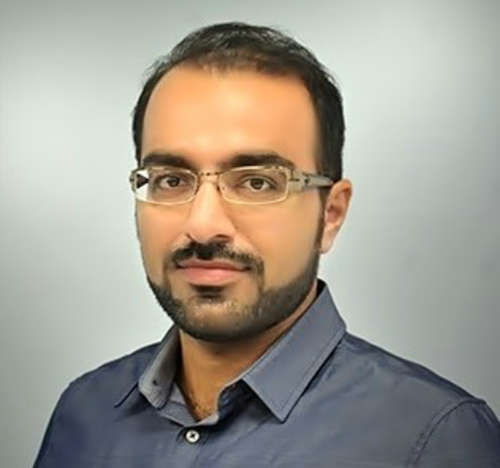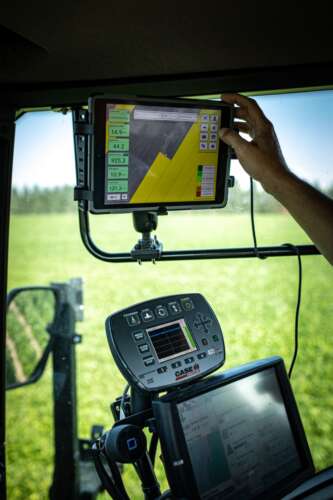Canadian farmers have long fought off crop and livestock threats from diseases and pests. Now add to that the growing threat of cyber-attacks, as producers in Canada and abroad adopt more on-farm smart technologies.
So says a University of Guelph computer scientist whose lab is the only Canadian university research centre investigating an increasing number of cyber-attacks on farm networks. Besides helping farmers fight off hackers, Dr. Ali Dehghantanha hopes his pioneering research helps to arm producers in preventing such attacks and spurs governments to develop data security standards for the agricultural sector.

“We need to think about it before things get out of control,” said Dehghantanha, whose Cyber Science Lab is part of the School of Computer Science within U of G’s College of Engineering and Physical Sciences.
His research group has teamed up with U of G food experts on first-time studies of aspects of smart farming and cyber-threats, including a 2022 survey of on-farm wireless technologies.
With rising food demand, growing urbanization and climate change, food insecurity is a growing challenge worldwide, said Dehghantanha. He holds the Canada Research Chair in Cybersecurity and Threat Intelligence and is director of U of G’s master of cybersecurity and threat intelligence program.
To help ensure food security, producers are increasingly adopting smart farming and precision agriculture technology to grow and raise more food while reducing environmental impacts and waste from fertilizers and pesticides. But all those interconnected sensors, smart meters, cameras and other devices leave farmers more vulnerable to “data insecurity” and potential cyber-attacks.
His new paper reviewing current technology used on farms is the first Canadian research to investigate weaknesses and potential cyber-attack strategies and tactics in the agricultural sector.
First market research on growth of smart farming and cybersecurity in North America

In 2020, Dehghantanha co-authored the first-ever market research study looking at the growth of smart agriculture and cybersecurity in North America. That study found that as of 2019, the global smart agriculture market – consisting of various smart farming technologies – was worth more than $10 billion.
But spending on cybersecurity in smart agriculture accounts for only about three per cent of total cybersecurity spending in North America, far outpaced by spending on security in other applications from finance to health care.
“The level of cybersecurity protection in agriculture is minimal to non-existent,” he said. “The agricultural sector is a soft underbelly from a cybersecurity point of view.”
To ensure on-farm security – and, ultimately, food security in Canada and abroad – he said farmers need to make sure their technology can ward off three main kinds of threats.
One threat comes from cybercriminals using ransomware to effectively lock up digital systems and demand a ransom payment from the producer.
Another growing problem involves hackers stealing confidential information on anything from production rates to greenhouse temperatures to animal feeding schedules to supply chains. Those hackers then sell that data to clients, including competitors.
He said the most dangerous threat – and one that continues to grow – is posed by state-sponsored hackers aiming to help disrupt or control network systems. Interrupting farm supply chains, for instance, may mean farmers lose crops and ultimately lose time and money in replacing them. “Any disruption of infrastructure could cause disruption of the supply chain and affect food security.”
Suspected cyber-attacks on farming networks increasing
Worldwide, said Dehghantanha, most cyber threat activity involves Chinese and Russian hackers, although he added that hacking has also been detected from North Korea and Iran.
His research group of digital investigators is called roughly once a month by farmers or security companies to help in tracing suspected cyberattacks on farming networks. He said he expects the number of calls to increase.
Referring to the current war in Ukraine – considered a major world breadbasket for crops such as wheat – Dehghantanha said, “The war has shown the importance of the food supply chain. Cyber-attacks have the potential to cause disruption.”
His group is developing techniques and procedures to detect, analyze and respond to cyber-attacks on smart farming systems.
He said farmers need to practice “cyber hygiene” by updating systems, protecting private information and using authentication and password procedures. He urges producers to consider deploying cyberthreat monitoring systems available from various companies. And he suggests that producers build relationships with system vendors to ensure prompt response if problems occur.
“It’s too late if you search for a responder when you see a ransomware message,” said Dehghantanha.
He also hopes to alert legislators and government officials about the need for cybersecurity standards and regulations for the farming sector.
These projects have been supported by the Canada First Research Excellence Fund through U of G’s Food from Thought project.
Contact:
Dr. Ali Dehghantanha
adehghan@uoguelph.ca
